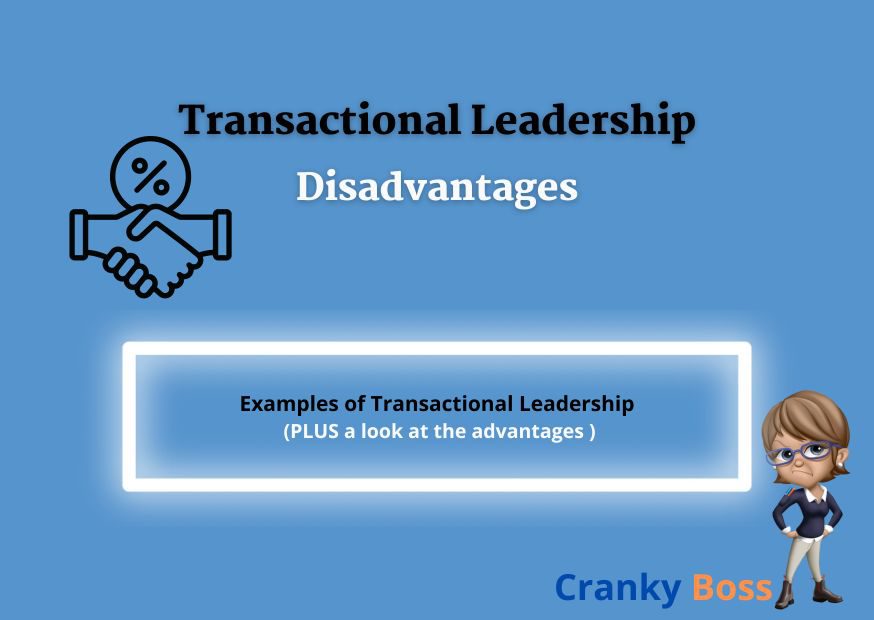Transactional leadership is a style of management where leaders use rewards and punishments to motivate their team. This approach can be effective in certain situations, but it also has several disadvantages. Let’s take a look at these disadvantages and look at examples, characteristics, and some advantages of transactional leadership to provide a well-rounded understanding of this leadership style.
I will also give you a personal example of when I implemented a style of transactional leadership and its pitfall.
Transactional Leadership Examples
To better understand transactional leadership, let’s look at a few examples:
- Sales Teams: In many sales teams, managers set clear targets for their employees. If the targets are met, employees receive bonuses or commissions. If not, they might face consequences like losing out on bonuses or getting a warning.
- Manufacturing Plants: Supervisors in factories often use transactional leadership to maintain productivity. Workers are rewarded for meeting production quotas and penalized for mistakes or failing to meet goals.
- Military: Military leaders often use transactional methods. Soldiers follow orders and complete missions with the understanding that their performance will be evaluated. Rewards include promotions and commendations, while poor performance can lead to demotion or disciplinary action.
These examples show that transactional leadership like pacesetting leadership is commonly used in environments where clear tasks and goals are essential.

Characteristics of Transactional Leadership
Transactional leadership has several key characteristics:
- Clear Structure: There is a well-defined structure and clear expectations for both leaders and followers. Employees know exactly what is expected of them.
- Reward and Punishment: Leaders use a system of rewards (like bonuses, promotions) and punishments (like warnings, demotions) to manage their team.
- Focus on Short-Term Goals: This leadership style emphasizes achieving short-term goals and tasks rather than long-term vision or innovation.
- Directive Leadership: Leaders give specific instructions and expect their team to follow them closely. There is little room for creativity or deviation from set tasks.
- Performance Monitoring: Leaders closely monitor the performance of their team and provide feedback based on whether targets are met or not.
These characteristics make transactional leadership very different from other styles, such as transformational leadership, which focuses on inspiring and motivating employees for long-term success.

Disadvantages of Transactional Leadership
While transactional leadership can be effective in certain situations, it has several notable disadvantages:
- Lack of Creativity: Because transactional leaders focus on following rules and procedures, there is little room for creativity and innovation. Employees are often discouraged from lateral thinking or thinking outside the box, which can hinder the growth and development of new ideas.
- Low Motivation: Over time, the reliance on rewards and punishments can lead to low intrinsic motivation among employees. They may start to feel like they are only working for the rewards and not because they are passionate about their job. This can result in a lack of engagement and enthusiasm.
- High Dependence on Leader: Employees in a transactional leadership environment often become very dependent on their leader for direction and guidance. This can limit their ability to work independently and develop their own problem-solving skills.
- Short-Term Focus: Transactional leadership’s emphasis on short-term goals can be detrimental in the long run. Companies might meet immediate targets but fail to innovate or plan for the future, which can harm their long-term success.
- Employee Burnout: The constant pressure to meet targets and the fear of punishment can lead to high levels of stress and burnout among employees. This can result in high turnover rates, as employees leave the organization in search of a less stressful work environment. Be mindful of the signs an employee is about to quit.
- Limited Employee Development: Because transactional leaders focus on performance and meeting targets, there is often little emphasis on personal development and growth of employees. This can result in a workforce that is well-trained in specific tasks but lacks broader skills and abilities.

Advantages of Transactional Leadership Style
Despite its disadvantages, transactional leadership also has several advantages:
- Clear Expectations: Employees know exactly what is expected of them and what they need to do to succeed. This clarity can lead to increased efficiency and productivity.
- Consistency: The structured approach ensures consistency in performance and outcomes, which can be particularly beneficial in industries where precision and reliability are crucial.
- Short-Term Achievements: Transactional leadership is effective in achieving short-term goals quickly. This can be useful in situations where immediate results are needed.
- Simple to Implement: The transactional leadership style is straightforward and easy to implement. Leaders can quickly establish a system of rewards and punishments to manage their teams.
- Effective in Crisis Situations: During crises or emergency situations, the clear structure and decisive action typical of transactional leadership can help navigate the organization through difficult times.
Personal Example: The Pitfalls of Transactional Leadership
To illustrate the disadvantages of transactional leadership, let me take you through a personal example:
As an owner of a manufacturing company, I was eager to reduce errors and boost productivity among my team. Believing in the effectiveness of transactional leadership, I devised a system where a significant bonus would be distributed among employees if no errors were made during a 3-month period. However, for every error that occurred, I decided to deduct a certain amount from the total tally, regardless of who made the error. My intention was to foster teamwork by making the penalty a collective responsibility, while also providing opportunities to regain lost money through increased production.
Unfortunately, the results were not as I had hoped. Rather than promoting collaboration, the penalty system sparked a blame game among team members. Hostility quickly arose as individuals sought to avoid being held accountable for errors. Instead of working together to prevent mistakes, they were focused on deflecting blame onto others.
Moreover, the pressure to make up for lost money through increased production led to compromised work quality. Employees rushed through tasks, sacrificing accuracy for speed, which only exacerbated the problem of errors.
Despite my intentions to incentivize excellence and foster teamwork, the transactional leadership style I employed had the opposite effect. It not only failed to achieve its objectives but also damaged morale and cohesion within the team. My workplace became a jungle of office politics!☹️
As a result, I made the decision to quickly abandon the transactional leadership model and explore alternative strategies that prioritize collaboration, motivation, and continuous improvement. This personal experience served as a valuable lesson in the complexities of leadership and the importance of considering the broader implications of management styles on team dynamics and performance.
Summing Up
Transactional leadership is a management style that relies heavily on a system of rewards and punishments to motivate employees. While it can be effective in certain settings, such as sales teams, manufacturing plants, and the military, it also has significant disadvantages. These include a lack of creativity, low intrinsic motivation, high dependence on the leader, a short-term focus, potential for employee burnout, and limited opportunities for employee development.
Despite these drawbacks, transactional leadership offers some advantages, including clear expectations, consistency, the ability to achieve short-term goals, ease of implementation, and effectiveness in crisis situations. Leaders should carefully consider these factors when deciding whether transactional leadership is the right approach for their organization. By balancing the strengths and weaknesses of this style, they can better navigate the complexities of managing their teams and achieving organizational success.

